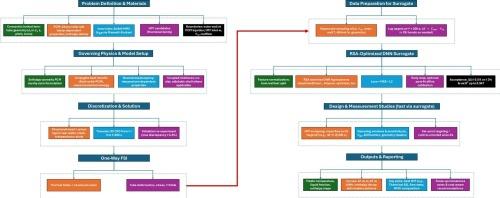基于RSA-DNN验证的复合材料同心螺旋管增强储能测量
IF 5.6
2区 工程技术
Q1 ENGINEERING, MULTIDISCIPLINARY
引用次数: 0
摘要
本研究提出了一个测量框架来评估一个同心螺旋储能单元的热和机械响应。该装置由两根盘管组成:内管携带传热流体(HTF),外管保持在二元太阳能盐的液相温度,作为相变材料(PCM)。通过焓-孔隙度方法对PCM填充环空进行建模,以捕获PCM和HTF的温度依赖特性的糊状层行为。内管为Al/AlN金属基复合材料(MMC);利用麦克斯韦-欧几肯关系计算其有效电导率。具有能量、动量和质量守恒的瞬态CFD与单向流固耦合(FSI)步骤相耦合,以量化管的变形。模型效度根据已发表的数据建立,最大偏差为5.2%。为了实现快速的性能评估,在模拟数据上训练了爬行动物搜索算法优化的深度神经网络(RSA-DNN),将操作/材料输入映射到出口-进口温升,并复制fsi信息的趋势。该方法的验证R2高达0.947,在整个操作包络线上的绝对误差≤0.5 K,同时保持了质量流量和AlN分数的预期单调趋势。作为一种应用,四种HTFs进行了基准测试:Therminol 62在200秒内达到48°C梯度,最低质量流量(50 g/s),而Therminol 66需要57.89 g/s。CFD-FSI建模与rsa优化的DNN代理的集成构成了一个新颖的、数据高效的框架,可以同时捕获pcm辅助螺旋系统的热响应和结构响应。这种对热机械性能的双重关注,结合了一种元启发式优化替代方法,超越了现有的基于pcm的交换剂研究。它能够快速筛选HTF/材料,减少对昂贵的模拟的依赖,并为紧凑、耐用和应用就绪的储能系统的设计提供信息。本文章由计算机程序翻译,如有差异,请以英文原文为准。

On the measurement of enhanced energy storage in composite concentric helical pipes with RSA-DNN verification
This study presents a measurement framework for evaluating the thermal and mechanical response of a concentric helical energy storage unit. The device comprises two coiled pipes: the inner pipe carries a heat-transfer fluid (HTF), and the outer pipe is maintained at the liquidus temperature of a binary solar salt that serves as phase-change material (PCM). The PCM-filled annulus is modeled via the enthalpy–porosity method to capture mushy-zone behavior with temperature-dependent properties for both PCM and HTF. The inner pipe is an Al/AlN metal–matrix composite (MMC); its effective conductivity is computed using the Maxwell–Eucken relation. Transient CFD with energy, momentum, and mass conservation is coupled to a one-way fluid–structure interaction (FSI) step to quantify tube deformation. Model validity is established against published data with a maximum discrepancy of 5.2%. To enable rapid performance estimation, a Reptile Search Algorithm–optimized deep neural network (RSA-DNN) is trained on simulation data to map operating/material inputs to the outlet–inlet temperature rise and to replicate the FSI-informed trends. The surrogate achieves validation R2 up to 0.947 and ≤0.5 K absolute error across the operating envelope while preserving expected monotonic trends with mass flow and AlN fraction. As an application, four HTFs are benchmarked: Therminol 62 attains a 48 °C gradient at 200 s with the lowest mass flow (50 g/s), whereas Therminol 66 requires 57.89 g/s. The integration of CFD–FSI modeling with an RSA-optimized DNN surrogate constitutes a novel, data-efficient framework that simultaneously captures thermal and structural responses in PCM-assisted helical systems. This dual focus on thermo-mechanical performance, combined with a metaheuristic-optimized surrogate, goes beyond existing PCM-based exchanger studies. It enables rapid HTF/material screening, reduces reliance on costly simulations, and informs the design of compact, durable, and application-ready energy storage systems.
求助全文
通过发布文献求助,成功后即可免费获取论文全文。
去求助
来源期刊

Measurement
工程技术-工程:综合
CiteScore
10.20
自引率
12.50%
发文量
1589
审稿时长
12.1 months
期刊介绍:
Contributions are invited on novel achievements in all fields of measurement and instrumentation science and technology. Authors are encouraged to submit novel material, whose ultimate goal is an advancement in the state of the art of: measurement and metrology fundamentals, sensors, measurement instruments, measurement and estimation techniques, measurement data processing and fusion algorithms, evaluation procedures and methodologies for plants and industrial processes, performance analysis of systems, processes and algorithms, mathematical models for measurement-oriented purposes, distributed measurement systems in a connected world.
 求助内容:
求助内容: 应助结果提醒方式:
应助结果提醒方式:


